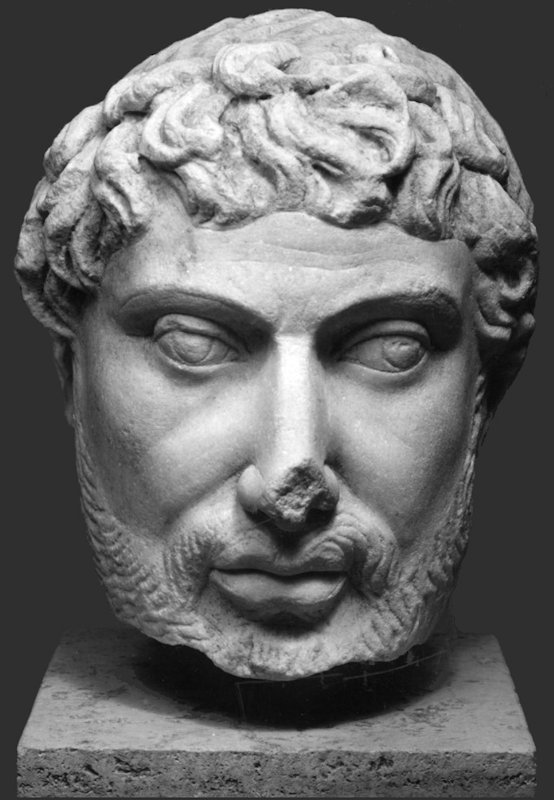Portraits
The portraits of Ostia have been studied systematically by Raissa Calza, but her work stopped in the middle of the third century. It was picked up from there by Ilaria Romeo in the series Scavi di Ostia (volume XVII). We'll have a look at some selected portraits here.
One probable portait of Maxentius has been identified, discovered near the Marine Gate. Romeo notes that we can see that he was cross-eyed, as noted by John Malalas, a chronicler from the sixth century: "He was short and broad with curly hair, fair-skinned with a good beard, a slight squint and an upturned nose" (Chronicle XII,47; translation E. Jeffreys - M. Jeffreys - R. Scott). But dating portraits - even though it is much easier than dating paintings - and identifying the person that was depicted, has for a long time caused headaches and intense debate. One portrait of a man, found on the street near the House of the Sacellum (IV,V,4), seems to be a re-worked portrait from the Constantinian period. The changes to the portrait have been dated to the same period, to the second half of the fourth century, and to the first half of the fifth century.


Portrait of Maxentius (?), found near the Marine Gate.
Romeo cat. nr. 13. Photo: ICCD E049920.Portrait found near the House of the Sacellum (IV,V,4).
Romeo cat. nr. 25. Photo: ICCD F005879.A colossal portrait found in the Baths of the Forum has been assigned by Romeo to c. 380-390 AD. It could be a ruler of the Valentinian dynasty, but Romeo also considers the possibility that it is Ragonius Vincentius Celsus, a prefect of the annona who is well-documented in Ostia. A portrait of a friendly looking man found on the street near the theatre would also belong to the late fourth century. Raissa Calza had dated it to around 325 AD, identifying the man as Crispus, a son of Constantine.


Colossal portrait found in the Baths of the Forum.
Romeo cat. nr. 21. Photo: ICCD E027288.Portrait found on the Decumanus near the theatre.
Romeo cat. nr. 26. Photo: ICCD F005877.A portrait of a child was found in the Baths of the Forum, in an underground service corridor in which numerous sculptures were excavated. It could well represent the Emperor Honorius. He was given the title Augustus in 393 AD and became Emperor of the western half of the Empire in 395 AD, at the age of ten. He occupied the throne until 423 AD. Quite exceptional was the discovery of the statue of a togatus with its portrait in the palaestra of the Baths of the Forum in 1940. It was made in the years 400-430 AD. On the toga are traces of red paint. The type of shoes points to equestrian status of this man, who, unfortunately, has not been identified (the equestrian status rules out earlier, senatorial identifications).
A portrait found on the street near the schola of Trajan has been dated to the first half of the fifth century by Romeo. To the second half of that century she assigns a portrait that was found in ruins to the north of the Decumanus, between the theatre and Via dei Molini, together with other, older portraits and sculptural fragments.


Portrait found on the street near the schola of Trajan.
Romeo cat. nr. 30. Photo: ICCD F005698.Portrait found in ruins to the north of the eastern Decumanus.
Romeo cat. nr. 31. Photo: Wikimedia, Sailko.An unfinished head inspired by the portrait of Alexander the Great has been assigned to the fifth century. It was found in a shop near the theatre that seems to have been used by a marble worker. It was stolen in 1958. The latest portrait discussed by Romeo belongs to the sixth century. It is significant that the piece was found in Portus, which was still important for supplying Rome, contrary to Ostia.


Portrait of "Alexander the Great", found near the theatre. Stolen in 1958.
Romeo cat. nr. 23. Photo: ICCD F009439.Portrait found in Portus.
Romeo cat. nr. 32. Photo: ICCD F005901.The context in which the portraits were found will surely clarify to the reader why Ostia, as it was found by the excavators, has been called a "battlefield".